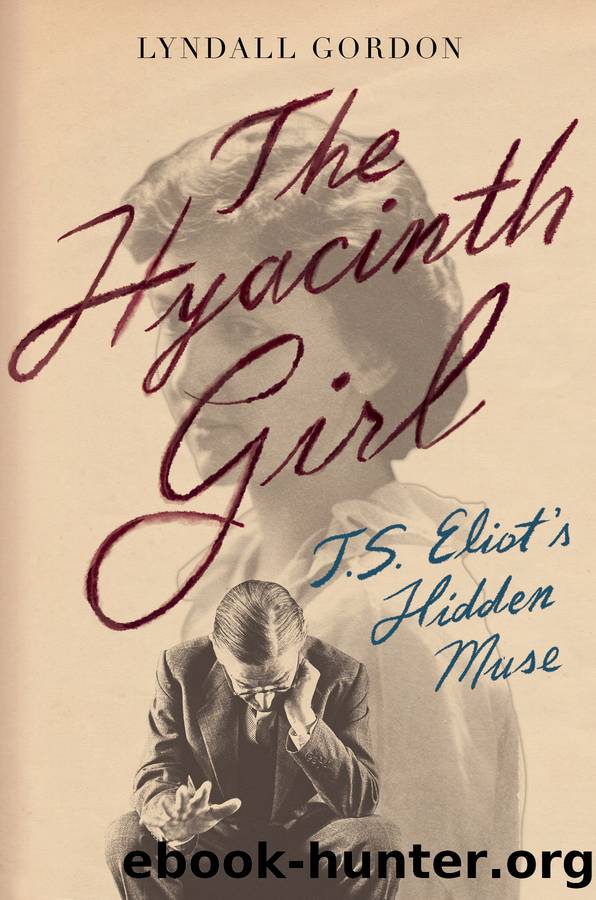The Hyacinth Girl by Lyndall Gordon

Author:Lyndall Gordon
Language: eng
Format: epub
Publisher: W. W. Norton & Company
In 1943, the year Eliot put the Quartets together as a book, he returned to the issue of their papers, declaring his sole motive was to archive her letters âas a kind of monument to youâ.
Emily seems now to entertain the idea, for that summer she asks him to go through her letters with a view to making a selection for eventual publication. He baulks, expecting this task to give him âmore heartaches than happinessâ. Why so is unclear, but their activity in building up an archive leads him ten days later to repeat his warning not to write in future âas if for publication, or for the perusal of future Willard Thorps!â
The following month, August 1943, Eliot makes a crucial statement to Emily. What he says is consistent with a curious motive, evident earlier, that it was her letters, not his, that mattered for his posthumous plan. Here is the telling sentence, prefaced by a playfully formal âMadamâ, an address used when he sensed Emilyâs independence from his control.
âMadam, may I say firmly ⦠that, for my purposes, it is quite sufficient that a selection of your letters should be preservedâ.
His own letters are dispensable, he says. Since he wrote them only for her, they could be destroyed at her death, if she so instructs. It is Emilyâs letters that must remain for posterity and a selection would suffice. At the foot of this letter he adds, âYour letters would go in a box, not to be opened, to the Bodleian.â There is a plan here, active from the start and somewhat opaque. While Emily began writing to Eliot in answer to a declaration of love, his concern with preservation complicates, even alters, the relationship.
The effect is of a correspondent as a work of art: a Pygmalion of sorts chiselling a statue of a woman with whom he falls in love. It is as if Eliot were writing letters in order to elicit hers for the purpose of a posthumous record that is to surprise the world, catch attention and reinvigorate future readers. Could this even be his prime purpose? If so, it fits Henryâs astute portrait of a brother with a âtalent for publicityâ.
The parallel between the mythical Pygmalion and the Eliot of the Hale letters is an imaginative stir in an artist inspired by love. Neither artist trusts women, but when Pygmalion kisses his lovely statue, she warms with the breath of life. This is exactly what happened with Emily in 1935 when Eliotâs kisses â at this point they lose count â wake her to love. Pygmalion married his work of art whereas Eliot held by the solitude an artist needs if he is to soar.
1943 was the annus mirabilis of his poetic career rather than the public honours that came later, for in that year the great work of his maturity Four Quartets was published: first in the US and a year later in England because of a paper shortage during the war. When Eliot
Download
This site does not store any files on its server. We only index and link to content provided by other sites. Please contact the content providers to delete copyright contents if any and email us, we'll remove relevant links or contents immediately.
4 3 2 1: A Novel by Paul Auster(11794)
The handmaid's tale by Margaret Atwood(7455)
Giovanni's Room by James Baldwin(6814)
Big Magic: Creative Living Beyond Fear by Elizabeth Gilbert(5359)
Asking the Right Questions: A Guide to Critical Thinking by M. Neil Browne & Stuart M. Keeley(5358)
Ego Is the Enemy by Ryan Holiday(4960)
On Writing A Memoir of the Craft by Stephen King(4667)
The Body: A Guide for Occupants by Bill Bryson(4587)
Ken Follett - World without end by Ken Follett(4448)
Bluets by Maggie Nelson(4263)
Adulting by Kelly Williams Brown(4236)
Eat That Frog! by Brian Tracy(4153)
Guilty Pleasures by Laurell K Hamilton(4120)
White Noise - A Novel by Don DeLillo(3832)
The Poetry of Pablo Neruda by Pablo Neruda(3820)
Fingerprints of the Gods by Graham Hancock(3740)
Alive: The Story of the Andes Survivors by Piers Paul Read(3733)
The Book of Joy by Dalai Lama(3700)
The Bookshop by Penelope Fitzgerald(3621)
